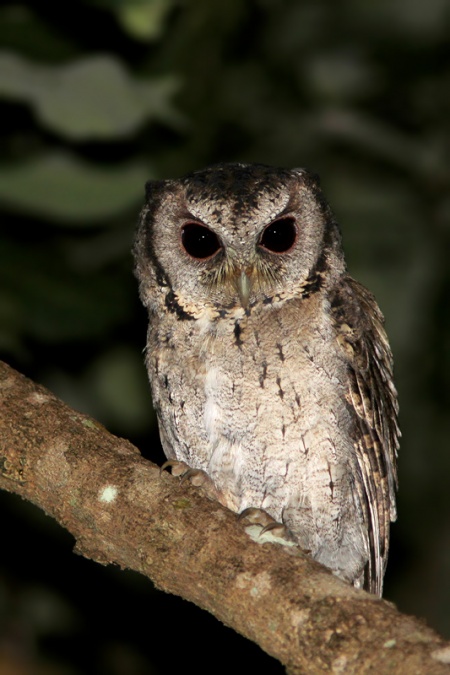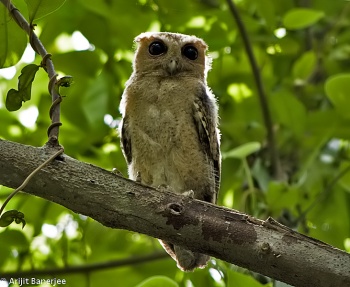(Clearer image added. References updated) |
m (→External Links: updated VSearch and GSearch) |
||
| (7 intermediate revisions by 3 users not shown) | |||
| Line 15: | Line 15: | ||
Adults are similar to but have paler upperside than [[Sunda Scops-Owl]]. Juveniles are not safely differentiated from juveniles of Sunda Scops-Owl<sup>[[#References|3]]</sup>. | Adults are similar to but have paler upperside than [[Sunda Scops-Owl]]. Juveniles are not safely differentiated from juveniles of Sunda Scops-Owl<sup>[[#References|3]]</sup>. | ||
==Distribution== | ==Distribution== | ||
| − | [[Image:8 5 ckbs CSO 1 of 1 -2 filtered.jpg|thumb|350px|right|Juvenile<br />Photo by {{user|ariban|ariban}}<br />Chintamoni Kar Bird Sanctuary, Kolkata, [[India]], May 2010]] | + | [[Image:8 5 ckbs CSO 1 of 1 -2 filtered.jpg|thumb|350px|right|Juvenile<br />Photo by {{user|ariban|ariban}}<br />Chintamoni Kar Bird Sanctuary, Kolkata, [[India]], 8 May 2010]] |
Eastern [[Himalayas]] to South-East [[Asia]], eastern [[China]], and [[Taiwan]]; ''ussuriensis'' is found north to Sakhalin Island. Most if not all of these populations are migrating south of this breeding range in winter, for example down into [[India]] and the [[Malay Peninsula]]. | Eastern [[Himalayas]] to South-East [[Asia]], eastern [[China]], and [[Taiwan]]; ''ussuriensis'' is found north to Sakhalin Island. Most if not all of these populations are migrating south of this breeding range in winter, for example down into [[India]] and the [[Malay Peninsula]]. | ||
==Taxonomy== | ==Taxonomy== | ||
| − | This species (''Otus lettia'') is sometimes considered a subspecies of ''[[Indian Scops Owl|Otus bakkamoena]]''; the latter species is currently called Indian Scops Owl, but if considered to include ''Otus lettia'', would be converted back the name Collared Scops Owl. [[Sunda Scops-Owl]] (''Otus lempiji'') is another species currently recognized in this superspecies. The species limits in this complex seems a little uncertain: an analysis<sup>[[#References|2]]</sup> including Indian Scops-Owl, Sunda Scops-Owl and subspecies ''lettia'' and ''ussuriensis'' of Collared Scops-Owl (and other species) failed to find ''lettia'' and ''ussuriensis'' as each others closest relatives. The authors speculate that ''ussuriensis'' instead might be closely related to [[Japanese Scops-Owl]]. Konig<sup>[[#References|3]]</sup> indeed includes ''ussuriensis'' as a subspecies of Japanese Scops-Owl. | + | This species (''Otus lettia'') is sometimes considered a subspecies of ''[[Indian Scops Owl|Otus bakkamoena]]''; the latter species is currently called Indian Scops Owl, but if considered to include ''Otus lettia'', would be converted back the name Collared Scops Owl. [[Sunda Scops-Owl]] (''Otus lempiji'') is another species currently recognized in this superspecies. The species limits in this complex seems a little uncertain: an analysis<sup>[[#References|2]]</sup> including Indian Scops-Owl, Sunda Scops-Owl and subspecies ''lettia'' and ''ussuriensis'' of Collared Scops-Owl (and other species) failed to find ''lettia'' and ''ussuriensis'' as each others closest relatives. The authors speculate that ''ussuriensis'' instead might be closely related to [[Japanese Scops-Owl]]. Konig<sup>[[#References|3]]</sup> indeed includes ''ussuriensis'' as a subspecies of Japanese Scops-Owl and so do now Clements and Gill and Donsker.. |
====Subspecies==== | ====Subspecies==== | ||
As currently defined, Collared Scops-Owl includes five subspecies<sup>[[#References|1]]</sup>: | As currently defined, Collared Scops-Owl includes five subspecies<sup>[[#References|1]]</sup>: | ||
| + | *''O. l. plumipes'': | ||
| + | :*Western Himalayas (northern [[Pakistan]] to western [[Nepal]]) | ||
*''O. l. lettia'': | *''O. l. lettia'': | ||
:*Eastern [[Nepal]] to [[Bangladesh]], [[Myanmar]], [[Thailand]] and [[Indochina]] | :*Eastern [[Nepal]] to [[Bangladesh]], [[Myanmar]], [[Thailand]] and [[Indochina]] | ||
*''O. l. erythrocampe'': | *''O. l. erythrocampe'': | ||
:*South-eastern [[China]] | :*South-eastern [[China]] | ||
| − | |||
| − | |||
*''O. l. glabripes'': | *''O. l. glabripes'': | ||
:*[[Taiwan]] | :*[[Taiwan]] | ||
*''O. l. umbratilis'': | *''O. l. umbratilis'': | ||
:*Hainan Island (southern China) | :*Hainan Island (southern China) | ||
| + | ''ussuriensis'' used to be included here but is now provisionally placed within [[Japanese Scops-Owl]]. | ||
==Habitat== | ==Habitat== | ||
Forests and well-wooded areas. | Forests and well-wooded areas. | ||
| Line 42: | Line 43: | ||
'''Call''': single soft ''whuk''. | '''Call''': single soft ''whuk''. | ||
==References== | ==References== | ||
| − | #{{Ref- | + | #{{Ref-Clements6thAug17}}#Fuchs et al. Tracing the colonization history of the Indian Ocean scops-owls (Strigiformes: Otus) with further insight into the spatio-temporal origin of the Malagasy avifauna. [http://www.pubmedcentral.nih.gov/articlerender.fcgi?tool=pubmed&pubmedid=18611281 BMC Evol Biol. 2008; 8: 197.] read in November 2008. |
#König, C., F. Weick, & J.-H. Becking. 1999. Owls - a guide to the owls of the world. Yale University Press. ISBN 0300079206 | #König, C., F. Weick, & J.-H. Becking. 1999. Owls - a guide to the owls of the world. Yale University Press. ISBN 0300079206 | ||
#Wikipedia | #Wikipedia | ||
{{ref}} | {{ref}} | ||
==External Links== | ==External Links== | ||
| − | {{GSearch|Otus | + | {{GSearch|"Otus lettia" {{!}} "Collared Scops Owl"}} |
| + | <br /> | ||
| + | {{VSearch|"Otus lettia" {{!}} "Collared Scops Owl"}} | ||
| + | {{GS-checked}}1 | ||
| + | <br /> | ||
| + | <br /> | ||
| − | [[Category:Birds]] [[Category:Otus]] | + | [[Category:Birds]] [[Category:Otus]] [[Category:Videos]] |
Latest revision as of 19:12, 20 June 2023
- Otus lettia
Identification
23-25cm
- Grey or brown upperparts
- Faint buff spots
- Buff, fine dark streaked below
- White or buff facial disc
- Orange or brown iris
- Buff neckband
- Small head tufts
Sexes similar
Both grey and rufous morphs are know; the difference in colour is mostly evident in the underside.
Similar Species
Adults are similar to but have paler upperside than Sunda Scops-Owl. Juveniles are not safely differentiated from juveniles of Sunda Scops-Owl3.
Distribution
Eastern Himalayas to South-East Asia, eastern China, and Taiwan; ussuriensis is found north to Sakhalin Island. Most if not all of these populations are migrating south of this breeding range in winter, for example down into India and the Malay Peninsula.
Taxonomy
This species (Otus lettia) is sometimes considered a subspecies of Otus bakkamoena; the latter species is currently called Indian Scops Owl, but if considered to include Otus lettia, would be converted back the name Collared Scops Owl. Sunda Scops-Owl (Otus lempiji) is another species currently recognized in this superspecies. The species limits in this complex seems a little uncertain: an analysis2 including Indian Scops-Owl, Sunda Scops-Owl and subspecies lettia and ussuriensis of Collared Scops-Owl (and other species) failed to find lettia and ussuriensis as each others closest relatives. The authors speculate that ussuriensis instead might be closely related to Japanese Scops-Owl. Konig3 indeed includes ussuriensis as a subspecies of Japanese Scops-Owl and so do now Clements and Gill and Donsker..
Subspecies
As currently defined, Collared Scops-Owl includes five subspecies1:
- O. l. plumipes:
- O. l. lettia:
- Eastern Nepal to Bangladesh, Myanmar, Thailand and Indochina
- O. l. erythrocampe:
- South-eastern China
- O. l. glabripes:
- O. l. umbratilis:
- Hainan Island (southern China)
ussuriensis used to be included here but is now provisionally placed within Japanese Scops-Owl.
Habitat
Forests and well-wooded areas.
Behaviour
Nocturnal.
Breeding
It nests in a hole in a tree. The clutch consists of 3-5 eggs.
Diet
The diet includes insects.
Vocalisation
Call: single soft whuk.
References
- Clements, J. F., T. S. Schulenberg, M. J. Iliff, D. Roberson, T. A. Fredericks, B. L. Sullivan, and C. L. Wood. 2017. The eBird/Clements checklist of birds of the world: v2017, with updates to August 2017. Downloaded from http://www.birds.cornell.edu/clementschecklist/download/
- Fuchs et al. Tracing the colonization history of the Indian Ocean scops-owls (Strigiformes: Otus) with further insight into the spatio-temporal origin of the Malagasy avifauna. BMC Evol Biol. 2008; 8: 197. read in November 2008.
- König, C., F. Weick, & J.-H. Becking. 1999. Owls - a guide to the owls of the world. Yale University Press. ISBN 0300079206
- Wikipedia
Recommended Citation
- BirdForum Opus contributors. (2024) Collared Scops Owl. In: BirdForum, the forum for wild birds and birding. Retrieved 11 May 2024 from https://www.birdforum.net/opus/Collared_Scops_Owl
External Links
GSearch checked for 2020 platform.1





